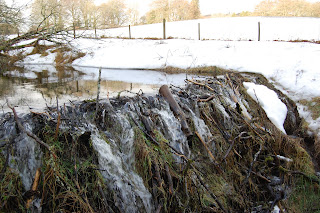Bardmony is a farm on the banks of the River Isla. The Ordnance Survey's map shows the crossing place under the name 'Boat of Bardmony', which indicates that a ferry took travellers across at least into the Middle of the nineteenth century, and possibly up to a century later. Louise and I left our car near the bridge and took the path along the flood defence (or levée?) that runs south of the river.
The floods have long since subsided and left behind a mixed detritus of coarse woody debris and an amazing jetsam of plastic bottles, balls, containers of mineral licks for farm stock.
Raising our eyes from the rubbish, we looked downstream, along this bank, bare of undergrowth in the winter, with groups of willow that are supplying the beavers with sustenance.
When we walked along this bank before Christmas there was a lodge here. The floods have washed the superstructure of branches away and the beavers have not returned.
Balbrogie was a grange of the nearby abbey of Coupar Angus. The Cistercian abbey was founded by King Malcolm IV in 1164 and has left its imprint on the history of the surrounding countryside.
The name Balbrogie comes from the Gaelic Baile Brogain: 'Brogan's township'.
This island, just south of the confluence of the Rivers Ericht and Isla was the subject of an extraordinarily misleading news item on BBC Radio Scotland a couple of days ago.
A fishing ghillie, John Muller, described the destructive activities of the beavers and how they had killed the willows on the island. Where there were many willows, there were now only a few, he declared.
Looking at the island from all sides it was hard for us to see the justification for Mr Muller's claims. There were signs of fresh activity, but nothing dramatic. Any cutting will be more than made good by the pulse of new shoots when the spring comes. The bare, exposed banks of the Isla have resulted more from grazing by livestock over the centuries than any recent cutting by beavers.
This is the north end of the little island by Balbrogie, looking up the Ericht. The Isla flows away to the east. You can make out a recent blow out of the bank that must have resulted from the recent floods.
We walked back up the path, marvelling at the imaginative capacities of the ghillie. What could he have been talking about? His description of the beaver he had seen, with its fierce orange teeth, would have done Little Red Ridinghood proud!
By this time the silver light of the overcast day had given way to brilliant sunshine.
A management plan for the riparian Isla should be prepared. Litter should be removed and a programme of planting of willow arranged. Interestingly the farm leases of the Abbey of Coupar Angus nearly always included the requirement for the tenant to plant willow (as well as to drain the land).
Some years ago the WWF ran a Wild Rivers' project to restore Scotland's canalised rivers. There should be a revival of this project.



















